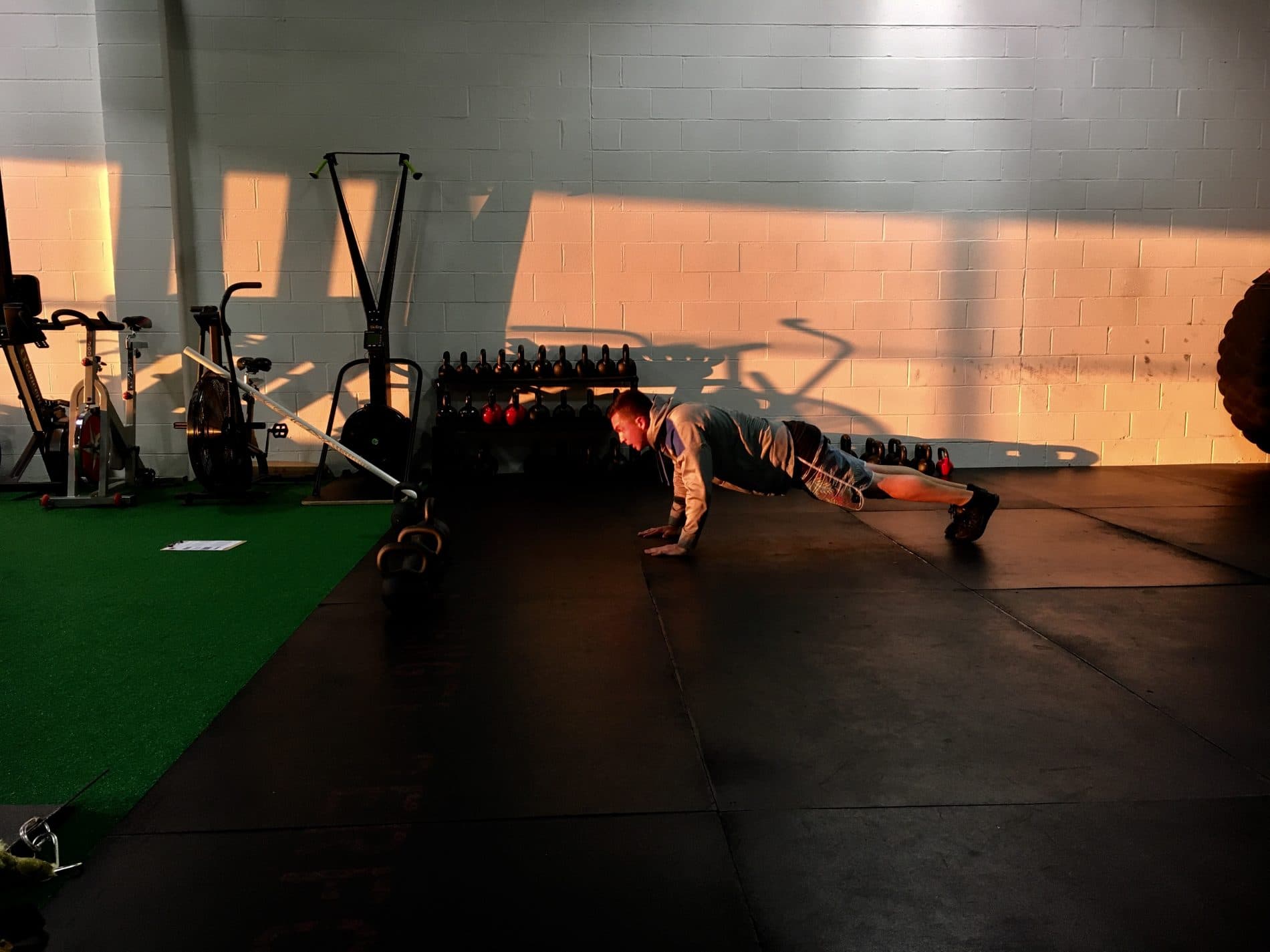You want to get a great workout in, to feel stronger, to move towards your goals. But you don’t have any equipment.
What do you do? Can you even get stronger without any equipment?
Sure, some gyms are open again after being closed down, like Beyond Strength Performance is now, but maybe you’re not comfortable yet to be back in a gym setting. I get that.
I could speak to how we’re able to keep people socially distant at BSP, how we can clean equipment more frequently than commercial gyms—I could do that. But I’m not.
If you’re not ready to be in a gym setting at the moment, that’s okay—you can still make progress towards your goals. Because it’s possible to make progress without any equipment.
It’s easy to fall into this line of thinking though, that you need a barbell, dumbbell, or kettlebell to get stronger. That, without equipment, you can only improve your cardio or endurance; but certainly not your strength.
There is truth to that, the thought that you need heavy weights, and, of course, having weights does help. Lifting weights—progressively heavier ones—over time is important to getting stronger. But that doesn’t mean it’s the only way.

For instance, a 2010 article for the National Strength and Conditioning Association had this to say (1):
“Bodyweight training is an effective means of conditioning and as with traditional weight training, when properly manipulated can produce favorable results in both physical strength and stamina.”
They found that bodyweight training produced results in physical strength and stamina. So it is possible.
But if research isn’t your stuff, then let me share an example with you.
One of our Beyond Strength superstars, whom I’ll call Ronnie (not his real name), has Powerlifted for years. Recently, before the lockdown, he started experimenting with Olympic Lifting, too. The dude likes to pick really heavy barbells up for fun. He deadlifts over 400 pounds, squats over 300, and benches over 225—he’s strong.
His problem during the lockdown was that he had no equipment at home besides a pull up bar.
Now, if you’re thinking that he lost a lot of his strength doing only bodyweight workouts, well, you’d be wrong. In fact, he came back to BSP once we re-opened and he was back to the same weights within a week or two.
Think about that for a second. He squatted over 300 pounds and maintained nearly all of his strength just squatting bodyweight.
And he got leaner, too.
How? He had a bodyweight workout that utilized three techniques to make bodyweight training more challenging.
The three techniques were:
- Tempo
- Fixed-Fixed and Density work
- Partial reps (1.5 reps and ratchet sets)
Let’s dig into each one by one.
Tempo
Tempo, or the speed at which we perform a movement, can be manipulated to make bodyweight exercises more challenging. We do this by slowing down the three parts of muscle contraction.
The eccentric portion of a lift is where the muscle is lengthening. This is typically the “lowering portion” of the lift as well. For example, when we are descending into a squat. Slowing this down increases the time that you are under tension during the movement, thus, making it more challenging.
An isometric is when you create tension but don’t move; when you pause, in other words. You can add a pause at the hardest part of the lift. For example, you could pause at the bottom of a squat. Also, you can pause anywhere during the movement, it doesn’t have to be the bottom.
Lastly, the concentric portion of a lift is where the muscle is contracting. Typically the “raising portion” of a lift, such as ascending from a squat.
In this video, you will see all three of these variations in tempo demonstrated with a squat, as well as using all three at once.
In short: slow down your movements during any of these phases to increase the time under tension and make them more challenging.
Fixed-Fixed And Density Work
Time can also be manipulated as well to increase the challenge of different bodyweight exercises.
Fixed-fixed means that the amount of work is fixed as well as the rest. For example, this might mean doing 20 seconds of work, with 40 seconds of rest. Or, 30 seconds of work, with 30 seconds of rest.
This allows us to get a lot of reps in during a short period of time. Also, the limited rest can allow us to get a cardiorespiratory bonus as well.
To make sense of this, let’s say you did a three exercise circuit for three rounds.
You did 25 seconds of work, with 35 seconds of rest for bodyweight squats, push-ups, and ½ floor batwings. Now, you not only have the chance to get as many reps as you can in 25 seconds, but you also get a lot of work done in a short period of time, as an added bonus.

Density work is similar in that it allows us to get a lot done in little time.
Density simply means you do a given number of reps at the start of every minute (or whatever amount of time you choose). For example, maybe you do 15 bodyweight squats at the start of a minute, and it takes you 30 seconds to do. That means you have 30 seconds of rest before the next minute starts.
We can knock out a handful of rounds relatively quickly and crank up the time under tension this way.
Lastly, we can also use partial reps to increase the suckitude—or amount of suck/challenge—of these movements.
Partial Reps (1.5 Reps and Ratchet Sets)
With bodyweight training, we can use partial reps to further increase the challenge of a movement. An easy way to do this is to use 1.5 reps for exercises.
A 1.5 rep is where you go through the eccentric phase of a movement, do half of the concentric, go back down, then return to the start position. This is easy to visualize when thinking of a squat.
We start standing. Then, we squat all way to our bottom position, come half way back up, descend back down, then stand up fully.
Ratchet sets are 1.5 reps from hell. They’re extra sucky. Instead of coming half way back up, you come up one quarter of the movement at a time.
For example, let’s look at the squat. You descend fully, come up ¼ of the way, go back down, then come up ½ way, go back down, come up ¾ of the way, go back down, then stand fully. That’s one rep. Yeah. Not fun. But, they do increase the challenge and time under tension needed to get stronger.
So there you have it. Three techniques to get stronger without any equipment.
You can slow down various parts of the movement to increase the time under tension, mess with the timing of the given exercises, or use partial reps to increase the difficulty.
As an added bonus, we also have a blog that includes two free bodyweight workouts if you’d like to get a workout in right now. You can check those out here.
And when you’re ready to get back into the gym and moving towards your goals, we’d love to help. You can click below to claim your free week.
Source:
- Harrison, Jeffrey S CSCS, NSCA-CPT Bodyweight Training: A Return To Basics, Strength and Conditioning Journal: April 2010 – Volume 32 – Issue 2 – p 52-55 doi: 10.1519/SSC.0b013e3181d5575c
You might also like:
- Why Learning the Push-up and Inverted Row Can Actually Improve Everything You Do in the Gym
- Struggling With Lunges? Then Check Out These Simple Tips
- How Cake Helps You Lose Weight
- Are your goals driving you to act, or are they just a nice idea?
- Metabolic Conditioning: Not Your Typical HIIT Workout
- Does Your Gym Understand You and Your Goals?
